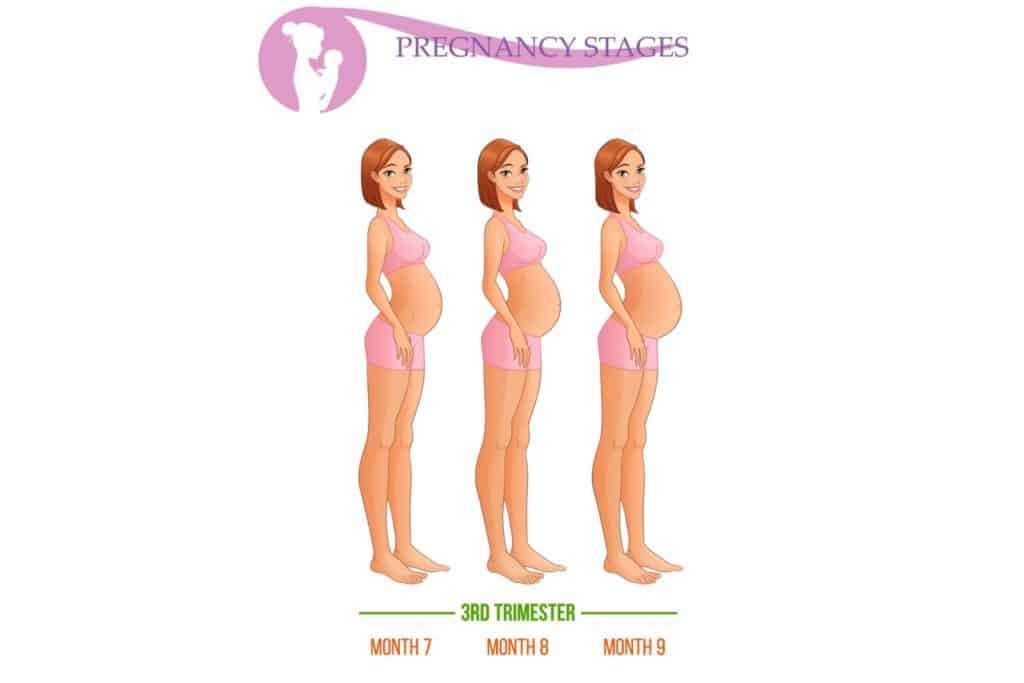
Congratulations on the competition of the second trimester! Great work! As you grow close to meeting your little one, some toughest symptoms come your way during the third trimester pregnancy, like fatigue and the urgent need to pee. You’ll also have new pregnancy symptoms like Braxton-Hicks contractions, hemorrhoids, pain, and anxiousness and it’s now time to take extra good care of yourself through naps and meditation. But again, it won’t be long enough and you’re almost there!
Here are all the things you could expect during the third trimester pregnancy.
Third Trimester Pregnancy; Weeks 28-42
- Week 28 – The baby now is around 14.8 inches that are approximately the size of a bowling pin. And when it’s finally time to meet your baby they’d be about 19-21 inches in length and would weigh from anywhere near 6 3/4 lbs to 10 lbs.
- Week 30 – The Baby now starts to put on around half a pound a week till their birth. It gets a bit cramped in the amniotic sac and space gets tighter resulting in the baby nestling into the position of a fetal.
Week 36 – The Baby now begins to shift their position downwards, away from the ribcage and toward the pelvis ready for birth. This is called “lightening,” as it is one of the early stages of labor. In the third trimester, the brain of the baby and the development is in full effect as they continue to develop the neural connections for the five senses. This helps the infant see, feel touch, taste, and hear when they’re born with signs of rapid movement in their eye.
Their bones are hardening while the skull is still soft at birth that allows the head to move through the birth canal. These soft spots are called fontanelles, and it takes a couple of years to develop.
- Week 36 – The kidney and liver of the Baby start to completely function as their brain and lungs continue to develop through childhood and beyond.
- Week 37 – The Baby is considered ready to get out and meet the world!
Third-trimester pregnancy symptoms
Braxton Hicks contractions
You may begin to experience Braxton Hicks contractions in your third trimester as the body prepares for labor. During these contractions, the uterine muscles get tightened at the interval of 30 seconds to two minutes.
To know the difference between a real contraction and the Braxton contraction is that the Labor contractions don’t ease up as you change positions or while you move around and they only increase in intensity and frequency. While on the other hand, Braxton Hicks contractions do ease by the breathing method taught in the childbirth classes.
- With the time nearly you would experience lower back and hip pain that are the connective tissues in the pelvic area. They will start to loosen as the hormone levels increase their levels and prepare the body for childbirth. You could help ease it a bit with regular exercise like walking, swimming, and stretching.
- In case you sense tingling, numbness, or even shooting pain in your lower back, thighs, and butt there are chances you have sciatica. This results when the uterus puts pressure on the sciatic nerves. To help ease yourself, try taking a warm bath or compress to soothe the pain.
- The pressure against your rib crib and diaphragm press against the uterus as it gets bigger resulting in shortness of breath. To help ease, try to stand up straight allowing yourself a room for “breathing” that the sleep also tries to prop yourself up with some extra pillows for comfort.
- One of the common symptoms of the trimester is mild swelling in the ankles or feet, however, if you experience sudden swelling in the face or the hands contact your doctor! It might be a sign of preeclampsia.
- You might experience shooting pain in the pelvis in particular your baby moves. It does cause discomfort but goes away quickly.
- Hemorrhoids are common in pregnancy. You might experience constipation and increased pressure in the pelvic at the same time. Remedies to ease this are witch hazel pads, sitz baths, and Tucks Pads or Earth Mama Herbal Perineal that relieves itching and pain. Also, drink a lot of water and consume fiber-rich foods, like oatmeal, beans, apples, and bananas.
If you experience severe cramping or abdominal pain, vomiting, painful or burning urination, bleeding, or a high fever, contact a doctor for your prenatal appointment.
Sleep and the Third trimester
In your third trimester, you’d tend to slow down again, and fatigue sets in again which results in difficulty in sleeping. It can also grow into discomfort due to the growing belly plus the anxiety.
A pregnancy pillow could be your pal here to help find yourself the comfort and if anxiety hits in try meditating to calm your mind.
Breast changes in the Third Trimester
Your breasts grow along with your belly and by the end of your pregnancy, they might increase up to 2 pounds! Nipples and areolas become more pronounced and darker with tiny bumps around also known as Montgomery’s tubercles. They secrete oil that keeps the area of the nipple lubricated while breastfeeding.
As you get closer to the due date they tend to begin leaking out a yellowish fluid or colostrum. This is immunity-rich milk for your baby in the first few days after their birth.
The third trimester is a good time to feed if you plan to breastfeed. It is recommended to read up a book like ‘Breastfeeding Made Simple’ and in place, you plan to work, pump out the milk in a bottle using a breast pump for your baby. Other than that you’ll need Nursing bras, nipple creams, nursing pillows, and nursing tops.
Obstetrician-gynecologist visits during the third trimester
As the date gets near you’ll meet a lot of healthcare providers and appointments turn out to be more frequent from 28 to 35 weeks.
What to expect from an appointment with my gynecologist in the third trimester of pregnancy?
At the gynecologist visits, you’ll need to screen your urine sample, check blood pressure, and measure the fundal height and fetal movement.
- In week 38, the doctor will examine the cervical to see them starting to dilate (opening of the cervix) or the efface that is the thinning of the cervix. A successful vaginal birth cervix measures 10 cm and 100% effaced.
- In between weeks 35 and 37 weeks, the gynecologist would ask to screen for Group B strep using a vaginal swab. This might not have any symptoms and the common bacteria is found in 25% of healthy women, if it turns out positive you will be given antibiotics through an IV during labor. This is to prevent the baby from contracting it.
- In week 35 you will be checked to see if the baby is headed downwards (cephalic) or upwards (breech).
Kick counts
You’d probably be used to feeling the baby’s kicks and jabs and to monitor the same try doing kick counts. You may choose to sit or lay in a quiet room to pay extra attention to the movements of the baby. Here, you need to look for ten distinct movements in the gap of two-hour.
In most cases, you might feel them within five minutes or might take longer. Try counting the kicks at the same time daily or mostly when the baby is active. This will help you notice the different patterns and if you don’t feel any movement call the doctor immediately.
White Discharge During Pregnancy in Third Trimester
Due to the increase in the estrogen levels, it is very common to have more white-colored vaginal discharge. And, if there are streaks of blood and if the discharge is gelatinous it may be due to a mucus plug that is an early sign of labor.
A little spotting is normal, especially after sex. This is due to the cervix that gets irritated quickly. Just in case you see a lot of blood contact the doctor, it might be due to the placenta.
Weight gain in the third trimester
You might have probably gained between 12 and 17 pounds in the second trimester. In the third trimester, you might gain anything between 1/2 pound and 1 pound per week resulting in 25 to 35 pounds by the time of birth.
Danger Signs of Pregnancy During Third Trimester
During the third trimester of pregnancy (weeks 28 to 40), it’s essential to be aware of certain signs and symptoms that may indicate potential complications. If you experience any of the following, it’s crucial to contact your healthcare provider promptly:
1. Vaginal Bleeding:
Any amount of vaginal bleeding should be reported to your healthcare provider. While some spotting can be normal, heavy bleeding could indicate a problem, such as placenta previa or placental abruption.
2. Severe Abdominal Pain:
Intense or persistent abdominal pain might be a sign of various issues, including preterm labor, preeclampsia, or other complications. Contact your healthcare provider if you experience severe discomfort.
3. Significant Changes in Fetal Movement:
Pay attention to your baby’s movements. A noticeable decrease in fetal movement or a sudden increase in activity may warrant investigation. Your healthcare provider may recommend monitoring fetal kicks or performing additional tests.
4. High Blood Pressure:
Elevated blood pressure can be a sign of preeclampsia, a serious condition that requires medical attention. Symptoms may include severe headaches, blurred vision, and swelling, especially in the hands and face.
5. Persistent Headaches or Vision Changes:
Chronic headaches or changes in vision, such as blurriness or seeing spots, could be associated with conditions like preeclampsia. Report these symptoms to your healthcare provider promptly.
6. Fluid Leakage:
If you experience a continuous trickle or gush of fluid from the vagina, it may indicate the rupture of the amniotic sac. This requires immediate medical attention to prevent infection and assess the baby’s well-being.
7. Shortness of Breath:
While some shortness of breath is normal in the later stages of pregnancy due to the growing uterus, sudden or severe difficulty in breathing may signal a problem, such as preeclampsia or blood clots.
8. Swelling:
While mild swelling of the feet and ankles is common, sudden or severe swelling in the hands, face, or legs could be a sign of preeclampsia. Report any significant swelling to your healthcare provider.
9. Signs of Preterm Labor:
Preterm labor symptoms include regular contractions, lower back pain, pelvic pressure, and changes in vaginal discharge. If you experience any of these signs before 37 weeks, contact your healthcare provider immediately.
Always consult with your healthcare provider if you have concerns or notice any unusual symptoms during your third trimester. Regular prenatal check-ups and open communication with your healthcare team are vital for a healthy pregnancy.
To Conclude; Third-trimester Pregnancy
The third trimester brings a lot of changes and here is a little checklist for you to go through:
Visit the hospital of the labor and see the delivery ward.
- Pack the hospital bag
- Decorate the nursery
- Make a playlist
- If you’re anxious, it’s natural. Do regular meditation to calm your mind
- Get the paperwork together for your maternity leave
- Prepare freezer meals
- Sign up for a local class to learn about breastfeeding
- Enjoy your baby shower.
- Take rest
- Make reservations for pre-baby dinner with your partner
- Download a contraction app timer before the active labor starts
- Check with the insurance to add your baby after birth
- Install a car seat
- Wash clothes you received at your baby shower
- Pick a pediatrician.










